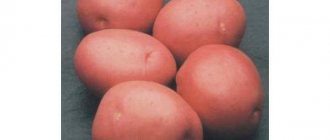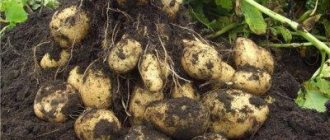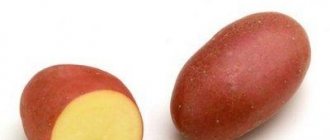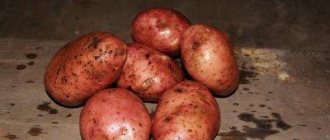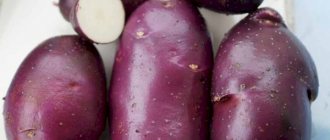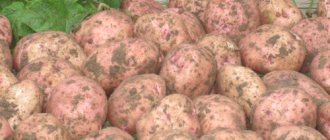Potato Rosana variety description
| Variety name | Rosana |
| general characteristics | early ripening variety with excellent taste and disease resistance |
| Maturation period | 70-75 days |
| Starch content | 13-14% |
| Weight of marketable tubers | 145 gr |
| Number of tubers in a bush | no data |
| Productivity | 145-245 c/ha |
| Consumer qualities | excellent taste, does not become overcooked, can be used for drying |
| Keeping quality | good |
| Peel color | pink |
| Flesh color | light yellow |
| Preferred Growing Regions | Central |
| Disease resistance | resistant to potato blight, golden potato cyst nematode and other viral diseases |
| Features of cultivation | requires pre-processing of the material before planting |
| Originator | bred in Germany |
Rosana potatoes are classified as early ripening varieties.
The full period from emergence to maturity of this potato lasts about 70-75 days. It was entered into the State Register of the Russian Federation for the Central Region. From one hectare of land usually harvests from 145 to 245 centners of crops.
This root vegetable has an excellent taste , does not overcook and can be used for drying and subsequent processing in dried form. It easily tolerates dry weather and does not impose any special requirements on the composition of the soil.
The Rosana potato variety exhibits resistance to various diseases , potato cancer, golden potato cyst nematode and other viral diseases.
Advice from experienced gardeners
Experienced vegetable growers have learned to increase yields using some tricks:
- Potatoes are grown using the ridge method using rotted sawdust and straw. This method significantly increases the quality and quantity of tubers.
- Potatoes are planted on ridges in early spring. In this way, plants use reserves of winter-spring soil moisture, which increases the number of tubers.
To guarantee a high yield, make the right bedding using rotted sawdust, mowed dry grass or rotted straw. Organic litter helps warm the soil in a short time, and when it decomposes, the crop receives additional nutrition.
Characteristics of potatoes
This variety of potato is characterized by medium-height bushes of an intermediate type, which can be either erect or relatively spreading. They are covered with leaves that can be medium or large in size. The leaves come in both closed and intermediate types, and their color can be green or dark green.
The corollas of these plants are large in size and have a purple color with a reddish tint. Rosana potato tubers have an elongated oval shape. The average weight of these tubers is 145 grams . They are covered with a smooth reddish skin. When cut, the pulp is light yellow in color. The starch content in root crops of this variety is at the level of 13-14%.
You can compare this indicator with other varieties using the data in the table below:
| Variety name | Starch content |
| Aurora | 13-17% |
| belongings | 12-17% |
| Rowanushka | 11-18% |
| Blue | 17-19% |
| Zhuravinka | 14-19% |
| Lasunok | 15-22% |
| Sorcerer | 13-15% |
| Granada | 10-17% |
| Rogneda | 13-18% |
| Dolphin | 10-14% |
Photo
In the photo you can see the Rozana potato variety:
Taste qualities
The most important factor influencing the prevalence of a particular potato variety, like any other vegetable crop, is its taste characteristics. This is not surprising, because potatoes are grown to be eaten, and everyone wants to eat tasty food.
"Rosara" is very tasty, soft and tender, and the flesh is not watery. At the same time, thanks to the yellow tint, both boiled potatoes and mashed potatoes look extremely appetizing
It is very important that the tubers do not become soft when cooked, so they are often used for making salads, when the boiled fruit is cut into small cubes or grated
Features of cultivation
This variety of potato requires pre-processing of the material before planting , which involves landscaping, germination and disinfection . This will help speed up the growth of bushes, increase productivity and protect the garden from diseases and pests.
IMPORTANT! When planting this type of potato, the distance between its bushes should be 60 centimeters, and between the rows - 35 centimeters.
The planting depth of tubers should be from 6 to 9 centimeters. Plantings should be placed in even rows in a north-south direction.
IMPORTANT! For optimal formation of potato tubers, the soil temperature should be between 17 and 20 degrees Celsius.
During the active growing season, watering should be insignificant, and at the stage of budding and flowering - more abundant.
Root and foliar feeding must be carried out on depleted soils, as well as in cases where the bushes develop weakly or slowly. How and when to apply fertilizers, as well as how to do it correctly when planting, read in additional materials.
To grow potatoes, it is very important to follow correct agricultural practices and use the right additives to increase yields and get rid of pests. We bring to your attention articles about why and how to properly use fungicides, herbicides and insecticides.
How to care
The main components of care include weeding and hilling the bushes.
Loosening and weeding
Rosara potatoes are responsive to loosening the soil. We carry out weeding and loosening until the tops close, every 8-12 days. Loosening the soil stimulates the formation of new roots and improves air access to them. We begin tillage when seedlings appear.
Hilling
The first hilling is carried out when the height of the seedlings is more than 10 cm, but if there is a threat of frost, we carry out hilling by covering the seedlings with soil. There is no need to unplant after the end of frost - the potatoes will come out on their own. We combine hilling with weeding and loosening, so that we can carry out 2-3 hillings per season.
Important: do not hill with dry soil. Hilling is done with damp soil, that is, after rain and watering.
Watering and fertilizing
Rosara potatoes do not require additional watering, but if there is a long absence of rainfall, they will have to be watered. There is no need for abundant watering, but the main thing is that the water reaches the roots; half a bucket is enough for the bush.
If mineral and organic fertilizer was applied during autumn digging or spring pre-planting tillage, then after planting there is no need for fertilizing. If you have not fertilized your garden either in the fall or in the spring, you are unlikely to do so during the growing season. But you can prepare “green” fertilizer by mixing herbal infusion with ash (a glass in a bucket) and feed the plantings.
Diseases and pests
Potato Rosana rarely suffers from various diseases .
However, you can carry out preventive spraying of plantings with chemicals. This should be done in cloudless weather, when the dew is completely dry. The ambient temperature will have to be 18 degrees Celsius.
You can read more about the most common nightshade diseases on our website: fusarium wilt, scab, alternaria, verticillium, late blight.
A solution of soap and ash will help protect the tops from the Colorado potato beetle. You can also use other folk methods or use chemicals.
The Rozana variety has a lot of positive qualities, including its good keeping quality and transportability .
That is why it has been occupying one of the leading positions among potato varieties for several years now.
You can see the shelf life indicators of other varieties in the table below:
| Variety name | Keeping quality |
| Kiranda | 95% |
| Minerva | 94% |
| Jewel | 94% |
| Meteor | 95% |
| Farmer | 95% |
| Timo | 96%, but the tubers germinate early |
| Arosa | 95% |
| Spring | 93% |
| Veneta | 87% |
| Impala | 95% |
We also bring to your attention a series of materials on storing potatoes: in winter, in boxes, in the refrigerator, peeled. And also what are the deadlines for this root vegetable.
What affects the productivity of Rosara
The presented culture is extremely unpretentious to growing conditions. The variety is resistant to potato nematodes and pathotype I cancer. He rarely suffers from common scab and late blight. Slightly susceptible to fungal diseases.
The productivity of Rosara is not at all affected by the climatic features of the region. This variety can be freely planted both in the arid Krasnodar region and in the Moscow region, Siberia, and central Russia. To get a good potato harvest, it is enough to regularly water it, apply fertilizer, and weed the beds.
Useful video
Watch a video about pink-fruited seed potatoes:
Below in the table you will find links to articles devoted to potato varieties that ripen at different times:
| Mid-late | Mid-early | Late ripening |
| Aurora | Black Prince | Nikulinsky |
| belongings | Nevsky | Asterix |
| Courage | Dark-skinned girl | Cardinal |
| Rowanushka | Lord of the Expanses | Kiwi |
| Blue | Ramos | Slav |
| Zhuravinka | Taisiya | Rocco |
| Lasunok | Lapot | Ivan da Marya |
| Sorcerer | Caprice | Picasso |

